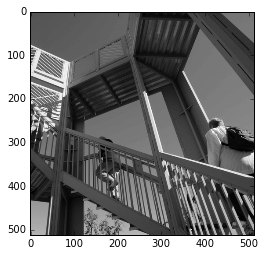SIFT image alignment tutorial¶
SIFT (Scale-Invariant Feature Transform) is an algorithm developped by David Lowe in 1999. It is a worldwide reference for image alignment and object recognition. The robustness of this method enables to detect features at different scales, angles and illumination of a scene. Silx provides an implementation of SIFT in OpenCL, meaning that it can run on Graphics Processing Units and Central Processing Units as well. Interest points are detected in the image, then data structures called descriptors are built to be characteristic of the scene, so that two different images of the same scene have similar descriptors. They are robust to transformations like translation, rotation, rescaling and illumination change, which make SIFT interesting for image stitching. In the fist stage, descriptors are computed from the input images. Then, they are compared to determine the geometric transformation to apply in order to align the images. This implementation can run on most graphic cards and CPU, making it usable on many setups. OpenCL processes are handled from Python with PyOpenCL, a module to access OpenCL parallel computation API.
This tutorial explains the three subsequent steps:
- keypoint extraction
- Keypoint matching
- image alignment
All the tutorial has been made using the Jupyter notebook.
%pylab inline
Populating the interactive namespace from numpy and matplotlib
# display test image
import scipy.misc
image = scipy.misc.ascent()
imshow(image, cmap="gray")
<matplotlib.image.AxesImage at 0x7f6e8be189e8>

#Initialization of the sift object is time consuming: it compiles all the code.
import os
os.environ["PYOPENCL_COMPILER_OUTPUT"] = "0" #set to 1 to see the compilation going on
from silx.image import sift
%time sift_ocl = sift.SiftPlan(template=image, devicetype="CPU") #switch to GPU to test your graphics card
CPU times: user 560 ms, sys: 60 ms, total: 620 ms
Wall time: 475 ms
/scisoft/users/jupyter/jupy34/lib/python3.4/site-packages/pyopencl/__init__.py:207: CompilerWarning: Non-empty compiler output encountered. Set the environment variable PYOPENCL_COMPILER_OUTPUT=1 to see more.
"to see more.", CompilerWarning)
print("Time for calculating the keypoints on one image of size %sx%s"%image.shape)
%time keypoints = sift_ocl(image)
print("Number of keypoints: %s"%len(keypoints))
print("Keypoint content:")
print(keypoints.dtype)
print("x: %.3f \t y: %.3f \t sigma: %.3f \t angle: %.3f" %
(keypoints[-1].x,keypoints[-1].y,keypoints[-1].scale,keypoints[-1].angle))
print("descriptor:")
print(keypoints[-1].desc)
Time for calculating the keypoints on one image of size 512x512
CPU times: user 1.49 s, sys: 140 ms, total: 1.63 s
Wall time: 860 ms
Number of keypoints: 491
Keypoint content:
(numpy.record, [('x', '<f4'), ('y', '<f4'), ('scale', '<f4'), ('angle', '<f4'), ('desc', 'u1', (128,))])
x: 287.611 y: 127.560 sigma: 47.461 angle: 0.503
descriptor:
[ 0 0 0 0 0 0 0 0 13 0 0 5 3 0 0 2 49 12
5 0 0 0 5 27 1 3 7 0 0 0 3 4 0 7 13 24
40 0 0 0 61 11 4 72 127 3 0 8 127 92 34 3 7 0
2 54 22 48 52 0 0 7 14 18 0 33 111 101 127 6 0 0
33 127 37 64 127 11 0 4 125 127 91 17 5 0 7 54 20 8
10 12 9 37 50 39 0 2 14 30 127 97 5 0 53 40 6 25
119 58 15 54 58 30 17 13 7 7 12 67 0 0 2 21 36 25
4 1]
#Overlay keypoints on the image:
imshow(image, cmap="gray")
plot(keypoints[:].x, keypoints[:].y,".")
[<matplotlib.lines.Line2D at 0x7f6ecdd796d8>]

#Diplaying keypoints by scale:
hist(keypoints[:].scale, 100)
xlabel("scale")
<matplotlib.text.Text at 0x7f6ea287e128>

#One can see 3 groups of keypoints, boundaries at: 8 and 20. Let's display them using colors.
S = 8
L = 20
tiny = keypoints[keypoints[:].scale<S]
small = keypoints[numpy.logical_and(keypoints[:].scale<L,keypoints[:].scale>=S)]
bigger = keypoints[keypoints[:].scale>=L]
imshow(image, cmap="gray")
plot(tiny[:].x, tiny[:].y,".g", label="tiny")
plot(small[:].x, small[:].y,".b", label="small")
plot(bigger[:].x, bigger[:].y,".r", label="large")
legend()
<matplotlib.legend.Legend at 0x7f6e34672da0>

Image matching and alignment¶
Matching can also be performed on the device (GPU) as every single keypoint from an image needs to be compared with all keypoints from the second image.
In this simple example we will simple offset the first image by a few pixels
shifted = numpy.zeros_like(image)
shifted[5:,8:] = image[:-5, :-8]
shifted_points = sift_ocl(shifted)
%time mp = sift.MatchPlan()
%time match = mp(keypoints, shifted_points)
print("Number of Keypoints with for image 1 : %i, For image 2 : %i, Matching keypoints: %i" % (keypoints.size, shifted_points.size, match.shape[0]))
from numpy import median
print("Measured offsets dx: %.3f, dy: %.3f"%(median(match[:,1].x-match[:,0].x),median(match[:,1].y-match[:,0].y)))
CPU times: user 28 ms, sys: 0 ns, total: 28 ms
Wall time: 24.9 ms
CPU times: user 76 ms, sys: 20 ms, total: 96 ms
Wall time: 22.5 ms
Number of Keypoints with for image 1 : 491, For image 2 : 489, Matching keypoints: 424
Measured offsets dx: 8.000, dy: 5.000
/scisoft/users/jupyter/jupy34/lib/python3.4/site-packages/pyopencl/__init__.py:207: CompilerWarning: Non-empty compiler output encountered. Set the environment variable PYOPENCL_COMPILER_OUTPUT=1 to see more.
"to see more.", CompilerWarning)
# Example of usage of the automatic alignment:
import scipy.ndimage
rotated = scipy.ndimage.rotate(image, 20, reshape=False)
sa = sift.LinearAlign(image)
figure(figsize=(18,5))
subplot(1,3,1)
imshow(image, cmap="gray")
subplot(1,3,2)
imshow(rotated,cmap="gray")
subplot(1,3,3)
imshow(sa.align(rotated), cmap="gray")
/scisoft/users/jupyter/jupy34/lib/python3.4/site-packages/pyopencl/__init__.py:207: CompilerWarning: Non-empty compiler output encountered. Set the environment variable PYOPENCL_COMPILER_OUTPUT=1 to see more.
"to see more.", CompilerWarning)
<matplotlib.image.AxesImage at 0x7f6e22502588>

References¶
- David G. Lowe, Distinctive image features from scale-invariant keypoints, International Journal of Computer Vision, vol. 60, no 2, 2004, p. 91–110 - “http://www.cs.ubc.ca/~lowe/papers/ijcv04.pdf“
